 |
 |
Our enthusiastic and extremely knowledgeable perennials team is here to answer your questions and help you choose the best perennials for your situation. There’s always something in bloom for sun, shade, butterflies, birds or deer resistance as well as a variety of bulbs for your space.
Stroll through our time-tested favorites and introduce yourself to the newest varieties. We garden with perennials too; we love them and it shows!
|
28 found, showing page 2 of 2

Height: 3 feet
Spacing: 30 inches
Sunlight: full sun
Hardiness Zone: 2a
Ornamental Features:
Karl Rosenfeld Peony features bold lightly-scented fuchsia flowers with yellow anthers at the ends of the stems from late spring to early summer. The flowers are excellent for cutting. Its compound leaves remain green in color throughout the season.
Landscape Attributes:
Karl Rosenfeld Peony is an herbaceous perennial with a more or less rounded form. Its medium texture blends into the garden, but can always be balanced by a couple of finer or coarser plants for an effective composition.
This is a relatively low maintenance plant, and should be cut back in late fall in preparation for winter. Deer don't particularly care for this plant and will usually leave it alone in favor of tastier treats. Gardeners should be aware of the following characteristic(s) that may warrant special consideration:
- Disease
Karl Rosenfeld Peony is recommended for the following landscape applications:
- Mass Planting
- General Garden Use
Planting & Growing:
Karl Rosenfeld Peony will grow to be about 30 inches tall at maturity, with a spread of 3 feet. When grown in masses or used as a bedding plant, individual plants should be spaced approximately 30 inches apart. The flower stalks can be weak and so it may require staking in exposed sites or excessively rich soils. It grows at a slow rate, and under ideal conditions can be expected to live for approximately 20 years. As an herbaceous perennial, this plant will usually die back to the crown each winter, and will regrow from the base each spring. Be careful not to disturb the crown in late winter when it may not be readily seen!
This plant should only be grown in full sunlight. It prefers to grow in average to moist conditions, and shouldn't be allowed to dry out. It is not particular as to soil pH, but grows best in rich soils. It is somewhat tolerant of urban pollution. This particular variety is an interspecific hybrid. It can be propagated by division; however, as a cultivated variety, be aware that it may be subject to certain restrictions or prohibitions on propagation.
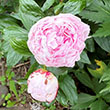
Height: 3 feet
Spacing: 30 inches
Sunlight: full sun
Hardiness Zone: 2a
Ornamental Features:
Sarah Bernhardt Peony features bold fragrant shell pink flowers at the ends of the stems from late spring to early summer. The flowers are excellent for cutting. Its compound leaves remain green in color throughout the season.
Landscape Attributes:
Sarah Bernhardt Peony is an herbaceous perennial with a more or less rounded form. Its medium texture blends into the garden, but can always be balanced by a couple of finer or coarser plants for an effective composition.
This is a relatively low maintenance plant, and should be cut back in late fall in preparation for winter. Deer don't particularly care for this plant and will usually leave it alone in favor of tastier treats. Gardeners should be aware of the following characteristic(s) that may warrant special consideration:
- Disease
Sarah Bernhardt Peony is recommended for the following landscape applications:
- Mass Planting
- General Garden Use
Planting & Growing:
Sarah Bernhardt Peony will grow to be about 30 inches tall at maturity, with a spread of 3 feet. When grown in masses or used as a bedding plant, individual plants should be spaced approximately 30 inches apart. The flower stalks can be weak and so it may require staking in exposed sites or excessively rich soils. It grows at a slow rate, and under ideal conditions can be expected to live for approximately 20 years. As an herbaceous perennial, this plant will usually die back to the crown each winter, and will regrow from the base each spring. Be careful not to disturb the crown in late winter when it may not be readily seen!
This plant should only be grown in full sunlight. It prefers to grow in average to moist conditions, and shouldn't be allowed to dry out. It is not particular as to soil pH, but grows best in rich soils. It is somewhat tolerant of urban pollution. This particular variety is an interspecific hybrid. It can be propagated by division; however, as a cultivated variety, be aware that it may be subject to certain restrictions or prohibitions on propagation.
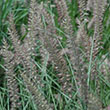
Dark, smoky rose-purple flower spikes. Deep green arching foliage. USDA 5-8

Dark, smoky rose-purple flower spikes. Deep green arching foliage. USDA 5-8
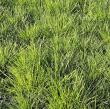
Rich-green fronds have a dense, upright growth habit. White, puffy plumes in late summer. USDA 4-9
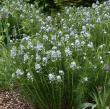
Long-lived plant with clusters of blue flowers in May and June and golden fall color on an upright, bushy plant. USDA 5-8
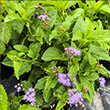
Bright blue minty leaves with purplish stems topped with masses of powder blue fuzzy flowers. Height 2-3'.
Eupatorium attracts bees and butterflies. Needs moisture if grown in full sun. Drought tolerate in shadier sites. Deer and rabbit resistant.
- USDA Hardiness Zone(s): 4-9
- Exposure: Full Sun, Part Shade
- Bloom Time(s): August-October
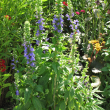
Tall spikes of blue blooms. Tolerates moist to wet soils. Native. USDA 4-9
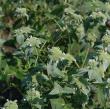
PYCNANTHEMUM MUTICUM 1 Gallon | Mountain Mint | Pink blooms. Fragrant silvery foliage. Naturalizing. Native. USDA 4-8
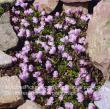
Lilac blooms. Dense groundcover. Light foot traffic. USDA 5-9
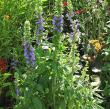
Tall spikes of blue blooms. Tolerates moist to wet soils. Native. USDA 4-9
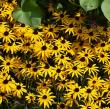
Plant Height: 24 inches
Flower Height: 3 feet
Spacing: 18 inches
Sunlight: full sun
Hardiness Zone: 3b
Other Names: Black Eyed Susan Description:
This vigorous variety has excellent disease and pest resistance; large yellow flowers with narrow petals and dark brown cones in late summer to early fall; ideal for gardens and containers; will freely self sow when seedheads are not picked
Ornamental Features:
Deam's Coneflower has masses of beautiful yellow daisy flowers with dark brown eyes and a orange flare at the ends of the stems from late summer to early fall, which are most effective when planted in groupings. The flowers are excellent for cutting. Its pointy leaves remain dark green in color throughout the season.
Landscape Attributes:
Deam's Coneflower is an herbaceous perennial with an upright spreading habit of growth. Its medium texture blends into the garden, but can always be balanced by a couple of finer or coarser plants for an effective composition.
This is a relatively low maintenance plant, and should be cut back in late fall in preparation for winter. It is a good choice for attracting butterflies to your yard, but is not particularly attractive to deer who tend to leave it alone in favor of tastier treats. Gardeners should be aware of the following characteristic(s) that may warrant special consideration: Self-Seeding
Deam's Coneflower is recommended for the following landscape applications:
- Mass Planting
- General Garden Use
- Container Planting
Planting & Growing:
Deam's Coneflower will grow to be about 24 inches tall at maturity extending to 3 feet tall with the flowers, with a spread of 24 inches. When grown in masses or used as a bedding plant, individual plants should be spaced approximately 18 inches apart. It grows at a fast rate, and under ideal conditions can be expected to live for approximately 15 years. As an herbaceous perennial, this plant will usually die back to the crown each winter, and will regrow from the base each spring. Be careful not to disturb the crown in late winter when it may not be readily seen!
This plant should only be grown in full sunlight. It prefers to grow in average to moist conditions, and shouldn't be allowed to dry out. It is not particular as to soil type or pH. It is highly tolerant of urban pollution and will even thrive in inner city environments. This species is native to parts of North America. It can be propagated by division.
Deam's Coneflower is a fine choice for the garden, but it is also a good selection for planting in outdoor pots and containers. With its upright habit of growth, it is best suited for use as a 'thriller' in the 'spiller-thriller-filler' container combination; plant it near the center of the pot, surrounded by smaller plants and those that spill over the edges. It is even sizeable enough that it can be grown alone in a suitable container. Note that when growing plants in outdoor containers and baskets, they may require more frequent waterings than they would in the yard or garden.
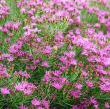
Purple blooms. Fine foliage. Well branched. Compact habit. USDA 4-9
28 found, showing page 2 of 2





